| | Published February 29th, 2012
| Leap Up and March On!
Digging Deep with Cynthia Brian
| | By Cynthia Brian | 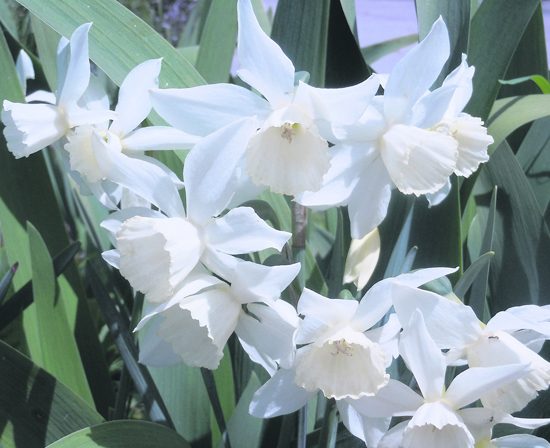 | | Daffodil-Innocence of pure white Photos Cynthia Brian
|
The buzz of the honeybees fills the morning air as I walk out my back door. The pollinators are busy savoring the sweetness of the flowering peach tree in full bloom. I love the sight, smell, and sound, however, these botanical gifts have arrived thirty-three days earlier than the normal March 17th blossom burst. It wasn't even Valentine's Day when spring sprung chez moi. Driving through Lamorinda over President's Day weekend, I stopped at three lemonade stands erected by entrepreneurial elementary school children. As much as I am a sun lover, without winter wetness our summer gardens may not yield.
I am amazed at how early my daffodils sprouted and bloomed. My jonquils flowered in early January and my first narcissus bloomed on February 6th. (Narcissus and daffodils are the same. Daffodil is the common name for the genus narcissus while a jonquil is a specific species with several strong-scented yellow florets with rounded leaves.) Usually in March I am romping through the mustard fields, not tromping around the daffodils. Besides the ubiquitous yellow daffodil that decorates roadsides, my hillside bloomers delight me with their varied throat colorations, frills, ruffles, and petal markings. Depending on the expert, there are 40-200 different species, subspecies, and varieties of daffodils with thousands of hybrids. Unlike tulips, the deer, squirrels, and rodents won't eat the bulbs or the blooms as they are poisonous to them. Easy to grow and tolerant of numerous weather conditions, daffodils can be planted in the sun, shade, and drifts for naturalization. Daffodils are the true trumpets of the vernal equinox.
|
|
Drought Tolerant Suggestions
In addition to cacti and succulents, these beauties provide a bounty of blooms throughout the growing season.
Agastache
Allium
Blanket Flower
Columbine
Coneflower
Daylilies
Echinacea
Globe Thistle
Lamb's Ears
Lavender
Penstemon
Sage
Salvias
Sedum
Sundrops
Yarrow
|
|
Spring is about looking forward and this year, we are leaping. We have bypassed the dark days of dormancy and are marching straight into the season of spring. We don't have to wait for the emergence of our favorite flowering fruit trees or Easter hellebore as they are already parading their newest wardrobes. Our weather is changing and our garden zones are also evolving. Updating the 1990 Plant Hardiness Zone Map, the U.S. Department of Agriculture has just released the newest version of this handy garden tool. The new map was jointly developed by the USDA's Agricultural Research Service (the chief intramural scientific research agency of the USDA) and Oregon State University's PRISM Climate Group. This new 2012 USDA Plant Hardiness Zone Map is the standard in gardening to determine which plants will thrive in which locations. It's based on the average annual minimum winter temperature, divided into ten degree Fahrenheit zones. Interestingly, most areas across the country are now rated at least a half a degree warmer. Lamorinda is rated in the 9B zone. The map is not yet available in printed form, but you can download it at the web site of http://planthardiness.ars.usda.gov.
With a possible drought in the works, as we contemplate our plantings, we must work with water-wise sensibilities. If you are considering installing a lawn or sod in March, you may want to plant a clover field or dicondra grass instead. The following drought-tolerant perennials are beautiful even in the hottest seasons and many have the added appeal of attracting butterflies, hummingbirds, and honeybees.
Of course, put daffodil bulbs on your fall want list as they are drought resistant and flourish in Lamorinda without disappointment. With so many colors available, there will be something for every gardener's penchant. I am including a variety of photos of my different daffodils for your enjoyment. This St. Patrick's Day, the flowering peach will have already finished its spectacular show, but the daffodils and shamrocks will continue to enchant. Savor the sunshine, leap up, and march on. Aram Go Braugh!
|
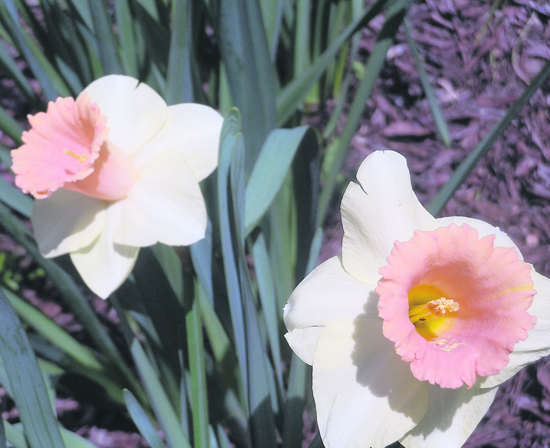 | | Daffodil-Peaches and Cream
| 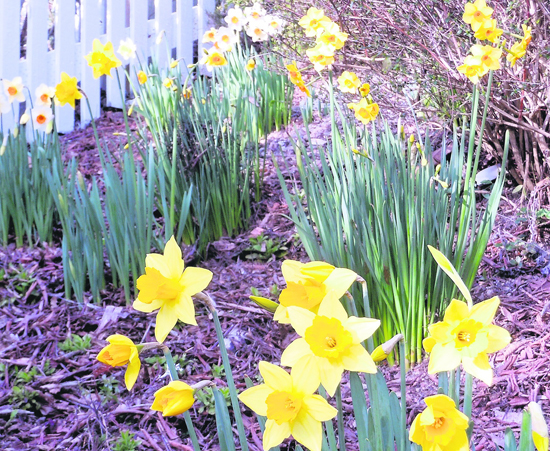 | | Several varieties of early blooming daffodils along the picket fence. Photos Cynthia Brian
|
|
Cynthia Brian's Gardening Guide for March
"Wheat and corn are important crops, no question about that. Butdaffodils provide nourishment too-for the soul." Charles Kuralt
When I think of daffodils, I visualize trumpets of singing sunshine and it makes me happy. Although this winter hasn't been too
dreary, the sight of daffodils stretching their necks skyward is always a welcoming messenger of the bright days ahead.
Inspiration strikes this month as our gardens wake up. Every day we find some new specimen to admire. Get up, get out, and
celebrate the Ides of March with a hoe, spade, and shovel.
- REPEL insects by planting nasturtium, marigold, calendula, wormwood, and pennyroyal.
- ATTRACT hummingbirds and butterflies with the red and pink wildflowers of penstemon, columbine, scarlet gilia, and Shirley poppy.
- GIVE an Easter or Passover gift that inspires health and happiness by filling baskets with a collection of herb seeds for an indoor or outdoor garden.
- PLANT a never-fail kid loving veggie garden with peas, lettuce, radishes, spinach, dill, and carrots.
- GO to the Bouquets to Art at the de Young Museum March 13-17 for the glorious annual floral eexhibitions matched to the art collection.
Visit --www.bouquetstoart.org.
- BUY azaleas, camellias, and rhododendrons now so you can choose colors that compliment your landscape.
- PREVENT compaction by not tramping on wet soil. Before planting seeds or seedlings, allow the dirt to dry to a cake mixture consistency.
- COLLECT fallen camellia florets. Rotting flowers left on the ground encourage petal blight.
- CUT a few branches from budding trees such as cherry or peach to enjoy the slow release of the sweet smelling, beautiful blooms.
- MARCH around your garden and finish the winter clean-up in preparation for our fast approaching spring.
- BUILD fruitful fences by trellising grapes or kiwis. You'll get privacy, autumn color, and nutritious food.
- TEACH kids patience and healthy eating by helping them plant an edible patch of strawberries, carrots, radishes, and peas. They'll get exercise,
sunshine, and feel proud of their culinary ac-complishments.
- GET a tetanus shot if you haven't had one recently. Digging in the dirt has its hazards.
- MIX nutrient based organic fertilizer into your beds. Till and dig well for eight inches to improve the soil and feed the roots.
- NEED a gardening based fundraiser? Renee's Garden Seeds offers a fundraiser program. Check out http://www.reneesgarden.com/fundraiser.html.
Seed donations are also available for non profit organizations planting community gardens.
- FERTILIZE lawns now with an organic high nitrogen mixture specifically for spring growth.
- NET your seeded area to protect from hungry birds and rabbits.
- DIG in your summer bulbs this month. Discover the colors and types you want at your local garden center. Gladioli come in a kaleidoscope
of colors but are a favorite food for deer.
- PLANT sweet peas as soon as the soil is warm enough and once they start blooming, cut huge bouquets for indoor beauty.
- ADD life and movement to your garden with a water feature for the benefit of all.
- CHECK out the 2012 USDA Plant Hardiness Zone Map at http://planthardiness.ars.usda.gov
- FIND out the worth of your special tree with a new free APP by Davey Trees. Go to value.m.davey.com from your mobile device.
- OOPS! My apologies for omitting the beautiful gardens at Heather Farms from my list of public and botanical gardens to visit locally. March is a great time to visit.
The Gardens at Heather Farm
1540 Marchbanks Drive
Walnut Creek, Ca 94596
www.gardenshf.org
(925) 947-1678
Open Year Round. Free
Thank you to everyone for your emails with compliments, questions, and suggestions. Digging Deep is
for you and I am honored to be your garden guide.
Celebrate St. Patrick's Day with a container of oxalis on your table. Another name for oxalis
is shamrock! Wishing you the luck of the Irish.
Happy Gardening to You!
|
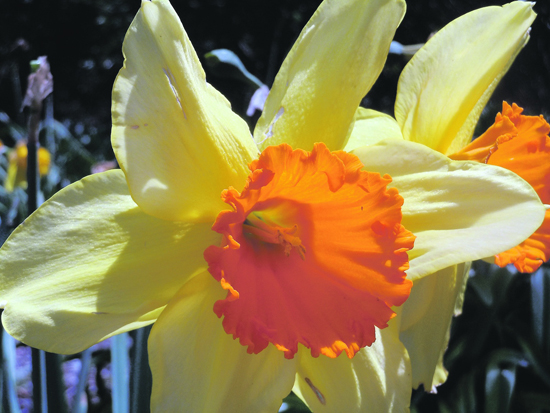 | | Daffodil-Yellow with deep orange throats
| 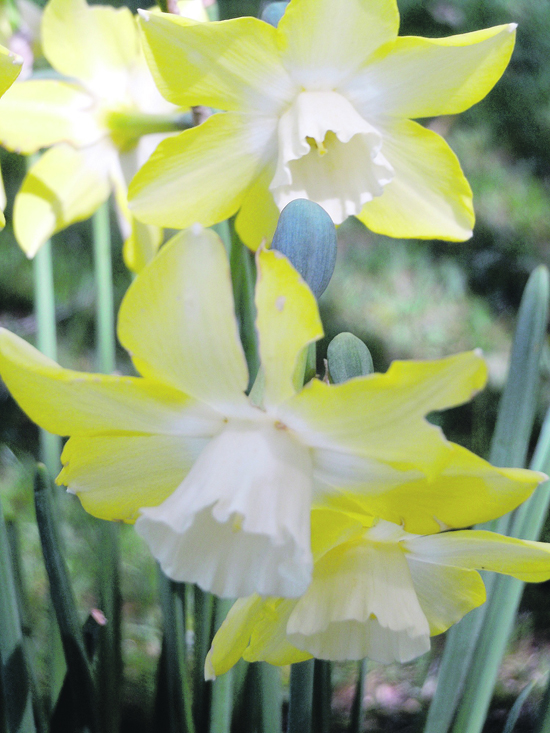 | | Daffodil-Lemon and Lace Photos Cynthia Brian
|
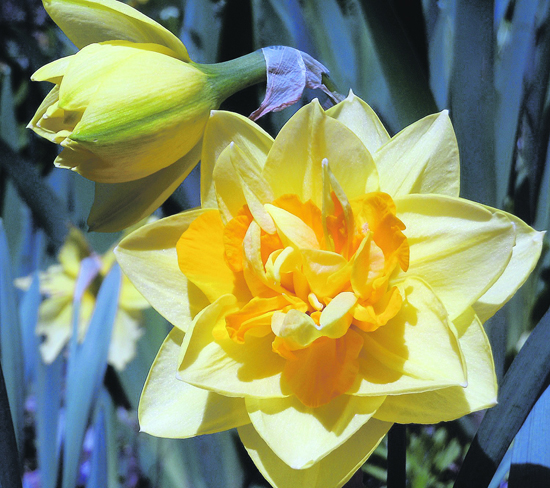 |
| Daffodil-Triple Threat |
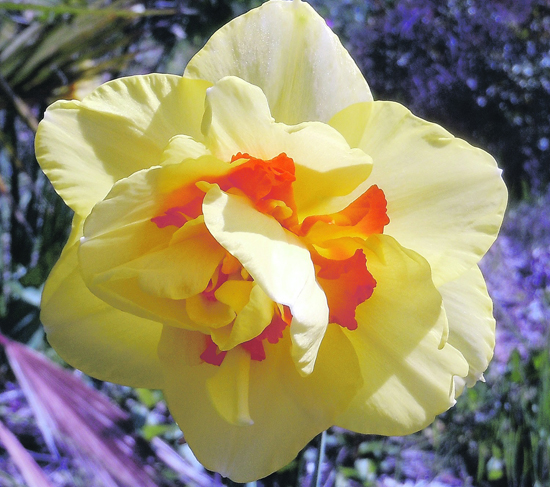 |
| Daffodil-Ruffled yellow and orange |
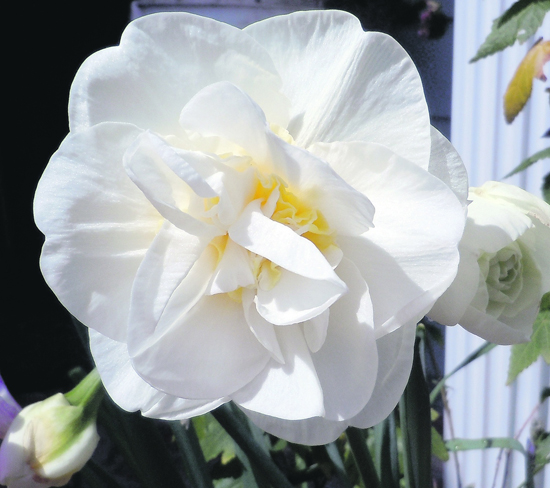 |
| Daffodil-White Ruffles |
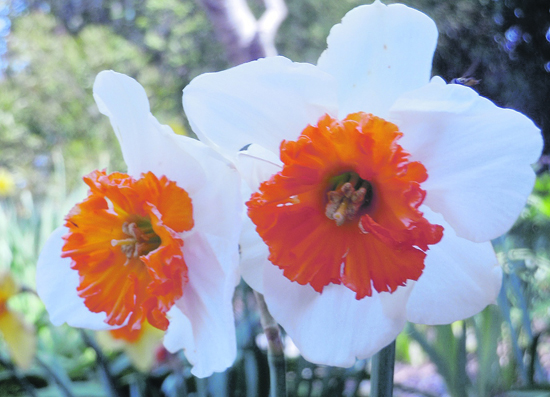 |
| Daffodil-White petals, Deep Orange frilly trumpet |
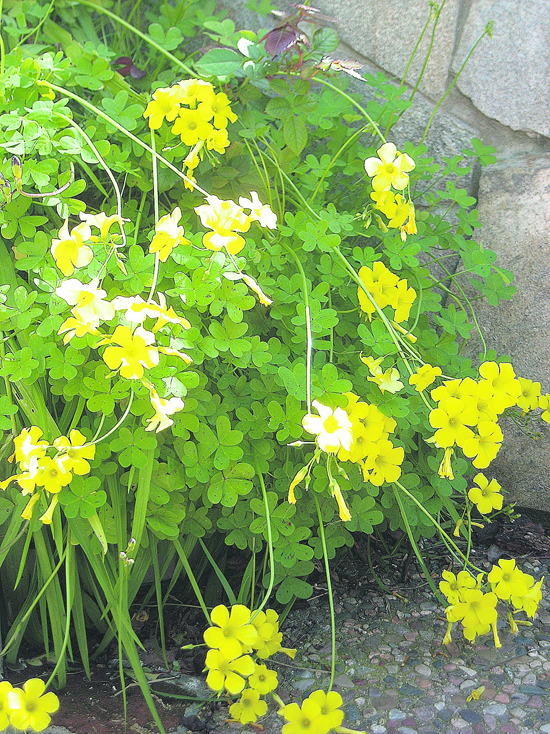 |
| Oxalis, also known as the Shamrock plant, is perfect for St. Patrick's Day on March 17. |
| | | | Advertisement
| | |
| | | print story
Before you print this article, please remember that it will remain in our archive for you to visit anytime.
download pdf
(use the pdf document for best printing results!) | | | Comments | | |
| | | | | | | | | | | | | | | | |











